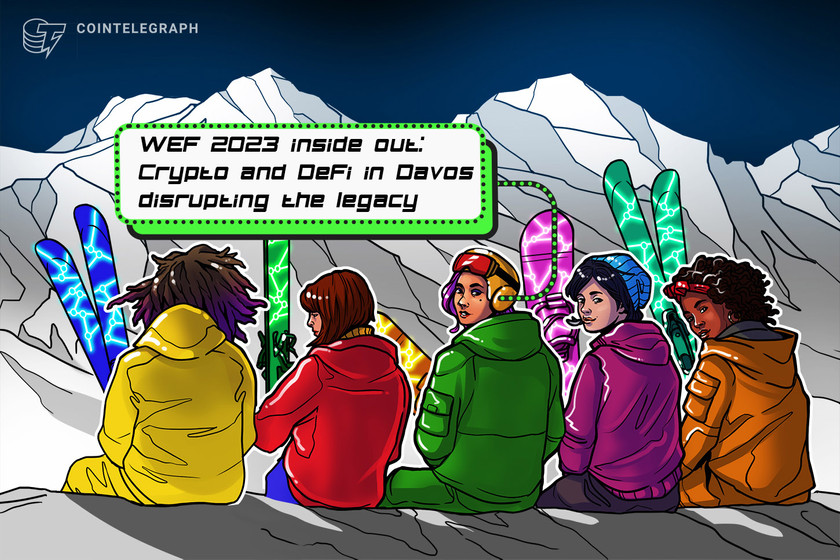Here’s how the World Economic Forum leaps into the metaverse — Davos 2023


Industry insiders highlight World Economic Forum workshops on the metaverse focusing on user privacy, asset protection and regulation.
Web3 and the metaverse were handed a seat at the table of the World Economic Forum (WEF) in 2023 as the ecosystem continues to drive innovation across industries.
As Cointelegraph continues to explore WEF, the presence of the cryptocurrency and blockchain ecosystem was mainly found outside the walls of the forum. Blockchain Hub Davos and the Global Blockchain Business Council’s “Blockchain Central” were two central events in town that brought together the wider crypto community that has been somewhat left out of the WEF’s discourse on the sector.
The metaverse is a notable exception. Although some metaverse applications do not operate on decentralized blockchain systems, key proponents for the space have been involved in high-level workshops within the WEF that look to understand and plan for the future integration of innovative technology.
The WEF agenda featured two workshops directly addressing the metaverse as part of the conference’s “Defining and Building the Metaverse” initiative in 2023.
The first workshop, “A New Reality: Building the Metaverse,” featured Meta’s chief product officer Chris Cox, while a second, titled “Deployment in the Industrial Metaverse,” explored how industries can tap into the benefits of the metaverse while avoiding its disruptive potential.
Related: TradFi and DeFi come together — Davos 2023
The World Economic Forum is exploring metaverse experiences within the convention as well. The 2023 conference allowed delegates to experience the forum in its own 3D immersive digital sessions called the Global Collaboration Village.
A custom digital avatar allowed WEF delegates to explore Davos in the metaverse and experience tailor-made experiences during the weeklong conference. Decentralized or not, the organization is tapping into the potential of Web3 to offer more to delegates through virtual experiences.
Blockchain-based metaverse platforms were also present in Davos as the wider traditional finance industry, policymakers and delegates looked to continue learning about the promise of metaverse ecosystems and their potential influence.
Playing in The Sandbox
Cointelegraph talked with The Sandbox co-founder Sebastien Borget at an exclusive networking event known as the Swedish Lunch halfway through the week. Every January, the Schatzalp Hotel hosts the gathering, seeing swathes of WEF delegates dine and mingle on the snowy terrace of the picturesque venue located high above Davos.
The Sandbox has emerged as a popular decentralized metaverse platform worldwide. Its collaboration with mainstream brands and companies is a major drawcard, which is part of the reason Borget was involved in some high-level workshops on the metaverse inside the World Economic Forum in 2023.
Related: Inside the World Economic Forum: Circle, Ripple reflect on Davos 2023
Borget held meetings with government ministries and heads of digital transformation to open dialogue around empowering and protecting digital ownership and digital economies. He said this was a pertinent point considering that half of the world’s population is now beyond generation Z as digital natives:
“We still have to demystify a little bit what the metaverse is today and what it can be in three, five, 10 years from now.”
As a lens to conversations within the World Economic Forum centered on the metaverse, Borget revealed that stakeholders were focusing on considerations around data privacy and security:
“How can we make sure that metaverse platform will respect user privacy, that it will implement enough rules or controls to make sure that users can be safe and protected and their digital assets as well?”
Borget said he had the chance to speak with representatives of the European Parliament about its general data protection regulation, which came into effect in May 2018, as well as regulations around artificial intelligence, cryptocurrencies and how nonfungible tokens (NFTs) should be treated differently.


Borget believes regulation of the space is inevitable but hopes that these dialogues will ensure that the industry is afforded room to innovate and experiment. This could prevent the metaverse from being hamstrung by restrictive measures in the years to come:
“It’s a chance to make sure that those regulations will not be too prescriptive for entrepreneurs to really be able to build something interesting here and develop and push their ideas. And so we are involved as early on as possible in the dialogue rather than trying to solve the issue too late as well.”
The Sandbox co-founder highlighted the “productive” nature of the WEF metaverse workshops, describing the meetings as different from a typical conference featuring panels or talks. Working groups discussed key topics at length inside the WEF, while Borget had ample opportunity to network and collaborate with the wider crypto community at various events around Davos throughout the week.
‘We need a bigger voice’
The World Economic Forum and mainstream institutions seem keenly aware of the promise of Web3 functionality and metaverse experiences. Dirk Lueth and Idan Zuckerman, co-founders of metaverse platform Upland, shared these sentiments in conversation with Cointelegraph on a snowy Thursday evening outside of Blockchain Hub’s venue on the Promenade.
The pair were involved in speaking engagements and networking with crypto and blockchain minds. Conversations around metaverse applications provided a learning opportunity. Lueth highlighted the need for industry leaders to have a “bigger voice” among policymakers and industry leaders at conventions like the WEF.


“I think everybody’s pretty much bought into the idea that the web will evolve into an immersive version of it. It will take time, but people are realizing it and are taking the first steps to understand how they fit into the plan,” Zuckerman explained.
Decentralization is another important tenet that powers digital ownership and economies, according to Lueth. He believes that open metaverse networks provide a variety of entrepreneurial and media opportunities that closed systems might not provide.
Zuckerman offered a more thoughtful take, suggesting that the future of metaverses will become a hybrid featuring centralized and decentralized elements:
“I always look at decentralization; it’s not like a one or a zero; it’s a gradient. So there are some elements that need and should and could be decentralized and those will be the first ones.”
Examples of this were seen firsthand by Cointelegraph in Davos. Moderating a panel on metaverse adoption by institutions, two speakers represented mainstream metaverse solutions at the cutting edge of virtual reality.


Accenture’s David Treat unpacked their advanced extended reality technologies, while Vince Cacace touched on Vertebrae’s 3D and augmented reality commerce platform. Both projects operate on blockchain technology and serve mainstream institutions and commercial clients.
Related: Bitcoin dialogue at WEF requires ‘open-mind’ — Davos 2023
Interoperability could become an important part of the evolution of various metaverse platforms and applications, but Davos 2023 suggests that collaboration and innovation are already happening. Decentralized and centralized are already interoperable, providing a glimpse into the future of the space.
































